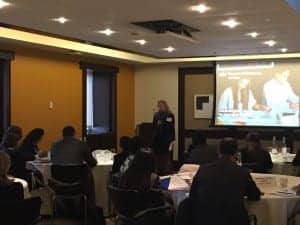 On the morning of April 15, 2015, 14 leaders of financial institutions across the globe that are committed to serving low-income women gathered in New York for the Executive Forum, a three-day workshop marking the beginning of the year-long Leadership and Diversity for Innovation Program (we’ve blogged about this program here). By participating in this program, these institutions are proving their commitment to women’s financial inclusion by making an investment in their people–each has nominated one senior executive and one high potential woman to participate in a series of engagements including classroom training, webinars and remote coaching. This focus on people was reflected by the leaders themselves: each leader was asked to give a word that summed up how others would define their leadership. The majority of the participants used words like teamwork, democratic, collaborative and caring. It was clear from the start that these leaders are committed not only to enhancing their leadership capabilities but also to empowering those around them.
On the morning of April 15, 2015, 14 leaders of financial institutions across the globe that are committed to serving low-income women gathered in New York for the Executive Forum, a three-day workshop marking the beginning of the year-long Leadership and Diversity for Innovation Program (we’ve blogged about this program here). By participating in this program, these institutions are proving their commitment to women’s financial inclusion by making an investment in their people–each has nominated one senior executive and one high potential woman to participate in a series of engagements including classroom training, webinars and remote coaching. This focus on people was reflected by the leaders themselves: each leader was asked to give a word that summed up how others would define their leadership. The majority of the participants used words like teamwork, democratic, collaborative and caring. It was clear from the start that these leaders are committed not only to enhancing their leadership capabilities but also to empowering those around them.
A program designed for results
The goal of the program is threefold:
- Building the leadership and management capabilities of the participating individuals,
- Giving an institution the opportunity to signal to staff and other stakeholders the importance of building a pipeline of diverse talent by sponsoring high-potential women, and
- Defining and achieving a strategic business initiative for better serving the women’s market.
The leaders and their institutions are tackling an impressive array of strategic business issues over the course of the year-long program, and beyond. They can be broadly categorized into four areas: (1) introducing new products including individual lending, savings and insurance; (2) growth and outreach, extending services to previously unreached or remote geographies and serving new segments of the women’s market; (3) using technology, such as introducing mobile or agency banking; and (4) the human side of change, for example building a program to develop female leadership talent among bank staff.

During the program, participants heard from a variety of faculty from Women’s World Banking, The Wharton School of the University of Pennsylvania and Creative Metier. Here are some highlights of the sessions:
- The Neethling Brain Instrument (NBI), a psychometric tool, provided the leaders with insights into their thinking preferences—how they make decisions, interact with their teams, their leadership strengths and possible blind spots. It will also help them to use the natural diversity on their teams to generate more creative solutions.
- Participants realized that while listening and questioning are seemingly simple skills that we use every day, we don’t often use them well. In fact, there are many barriers to listening, for example, thinking about what we want to say next can get in the way.
- Wharton Professor and Women’s World Banking Board Director Mike Useem gave the participants a checklist of leadership principles that will help them to truly inspire people to follow them. These include serving a purpose greater than themselves; believing in the mission; and recognizing the wealth of knowledge and influence held by the people within an organization, not just those at the top.
- Professor Martin Ihrig of Wharton helped participants to realize that contrary to what many people might think, you don’t necessarily need to invent or introduce something new to be innovative. What do you need to have? Something that the customer loves and adopts.
- Wharton Professor Kathy Pearson challenged the group, as leaders in their organizations, to practice behaviors that are more likely to lead to better outcomes when making difficult decisions in changing environments. These behaviors include keeping their heads up to survey their environment for future trends, challenging their mental models and not being afraid to “ask the dumb questions.”
Participants walked away with tools, frameworks and leadership lessons that they can apply to achieving their business objectives. The program also offered an opportunity for each leader to reflect on her or his personal leadership style and work closely with a group of peers to further crystallize how they think about business objectives and better conceptualize next steps towards achieving their goals.
We are excited to see what the program participants, and the women leaders from their institutions—all of whom are clearly driven by their passion for providing better financial products and services to low-income women in their markets—can accomplish over the next nine months. Even when they encounter challenges, changes and uncertainty we know that they will follow the guidance of Professor Useem who told the group, “If you believe in your mission, you can’t quit. Quitting is not a leadership strategy.”
The Leadership and Diversity for Innovation Program is being implemented in partnership with Credit Suisse with additional support from the Cisco Foundation.


